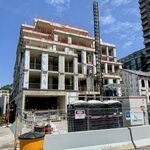I'm not sure where you're getting this claim, but completely rebuilding platforms at a lower level, rebuilding tracks, and modifying tunnels to add catenary would most certainly require a long full shutdown of the subway.
I just can't fathom how somebody who considers themselves to be a transit advocate could support, with a straight face, a long term shutdown of a busy subway line, so that it can be replaced at great cost with a lower capacity, lower-quality system. I also can't understand why transit "advocates" think that it's a good idea to relentlessly attack a major transit investment as a failure. Do they seriously believe that it will inspire more transit investment in the future? It's all the more galling because it's completely untrue. Compare Sheppard to Chicago's Green Line. Sheppard moves 48,000 people a day and is growing every year, despite being only half-built to its primary destination. The Green Line moves fewer than 40,000 per day even though it is five times as long as Sheppard. I can assure you that Chicago transit "advocates" don't go around calling the Green Line a failure and suggesting that it be torn up and replaced with a lower-capacity system.
The plan is to raise the tracks in the stations for the LRT's.
TTC could run trains on one track while the other is being converted. Headway would have to be increase to allow for one train to run from point to point. At the same time, both ends still could be use as duel tracks to allow 2 trains to operate while the other stations are being upgraded. Once the requirement to fix the ends, then one tracks will be taken out of service with longer headway. Buses would have to be added at this point.
Yonge station will require part of the platform to be cut and lower down for 2 cars. The section that has to be lower would see slopping ramp up to the existing platform. At some point, the subway trains have to be remove to raise the tracks on the other line platforms. This will mean buses have to run to provide extra service until the 2nd LRT line comes on line.
I can say with a straight face, if you got $10m to through away each year to operate the current line as well the $1.5B to provide service to 60,000 riders while over 200,000 gets nothing, go with a subway while I go with an LRT. You need to added in the millions to operate the subway that cannot be offset with low ridership.
You are forcing riders to make 3 transfers to get from the east to the west along Sheppard going your way. An LRT will offer 1 transfer if it stops at Downsview. If it goes to Weston Rd, then no transfer.
Until there is over 100,000 riders a day or 7,000 at peak time, LRT can provide the service.
At no time has Toronto gone from buses to streetcars to Subway based on ridership requirement. Yonge and BD have gone from Streetcars to Subway since streetcars were first on those routes in the first place.
I support Subways and do see a subway on Sheppard at some future date, but cannot support building one as an extension past Victoria at this time. I would build the extension to Downsview first and interline it with the YUS before going east. Since there is no money to do this now, LRT is the way to go. I would support a Queen line over the Sheppard if given the choice.
To put in the transit that is badly needed for Toronto, you need $50B over the next 20 years to do it. If Metrolinx has a problem now trying to do a $55B plan for the GTAH over 25 years, who going to pay the extra $40B to do Toronto now??
The Green Line moves fewer than 40,000 per day even though it is five times as long as Sheppard.
There are LRT's lines that move less than 20,000 in the US. Does that say buses should be use in place of LRT's? Sheppard sees less than 40,000 and how does that number support a subway when Finch let alone Dufferin that see 47,000 riders will only see buses??




